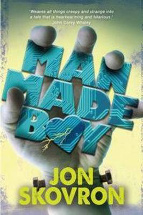Man made boy by Jon Skovron

Allen and Unwin, 2013. ISBN 9781743315132.
It is almost inevitable that as our world becomes increasingly
dependent on technology, face-to-face communication will become less
favourable. This prophecy is more relevant now than ever, as we
constantly toil to advance ourselves in that field.
It is also inevitable that in some way teenagers will always feel
the social pinch and emotional punch of adolescence - this inherent
angst has been exhibited in all settings where associated hormones
are present.
Both our increased reliance on plug-in tools and our collective
experience of youthful trial-and-error, are themes prevalent in Jon
Skovron's Man made boy, although in story and style they are
much simpler.
From the circuit-board font on the cover and the very first
paragraph, this work exudes a tech-savvy and highly contemporary
style, obviously as a means of updating the literary source it
references so heavily: Frankenstein.
In its time, Mary Shelley's seminal novel was tech-heavy - nuts and
bolts, elaborate scientific structure and a re-animation technique
powered by good old fashioned lightning.
Now, we have a cyberpunk influence, with computer-age language
littering the text. Somewhat surprisingly, this does not overshadow
a very traditional writing style, but instead complements it.
In terms of story, Man made boy concerns an aptly titled
teenaged hermit named Boy, and chronicles his experiences forming
his own personality and coming to terms with other relevant
emotional hurdles. In addition, Frankenstein-esque deformities have
created a low self-esteem situation for Boy, preventing him from
real interaction and exiling him to behind a computer screen.
Skovron has intentionally stripped our endearing protagonist of a
proper name to comment on the teenager's inherent need to categorize
themself and construct their personal traits. He makes clever,
humorous and insightful commentary on the epidemic of
technologically adept and addicted youth, and the potential social
problems which arise.
Aside from the thought-provoking content, the narrative is thrilling
and charming (and of course, full of knowing nods in jest to classic
horror literature.)
This is Frankenstein updated for a new audience - its themes
of creation, identity, isolation and misunderstanding still intact.
Man made boy is full of heart - re-assembled, stitched together and
calibrated with a micro-chip - but heart no less.
Henry Vaughan (Student)